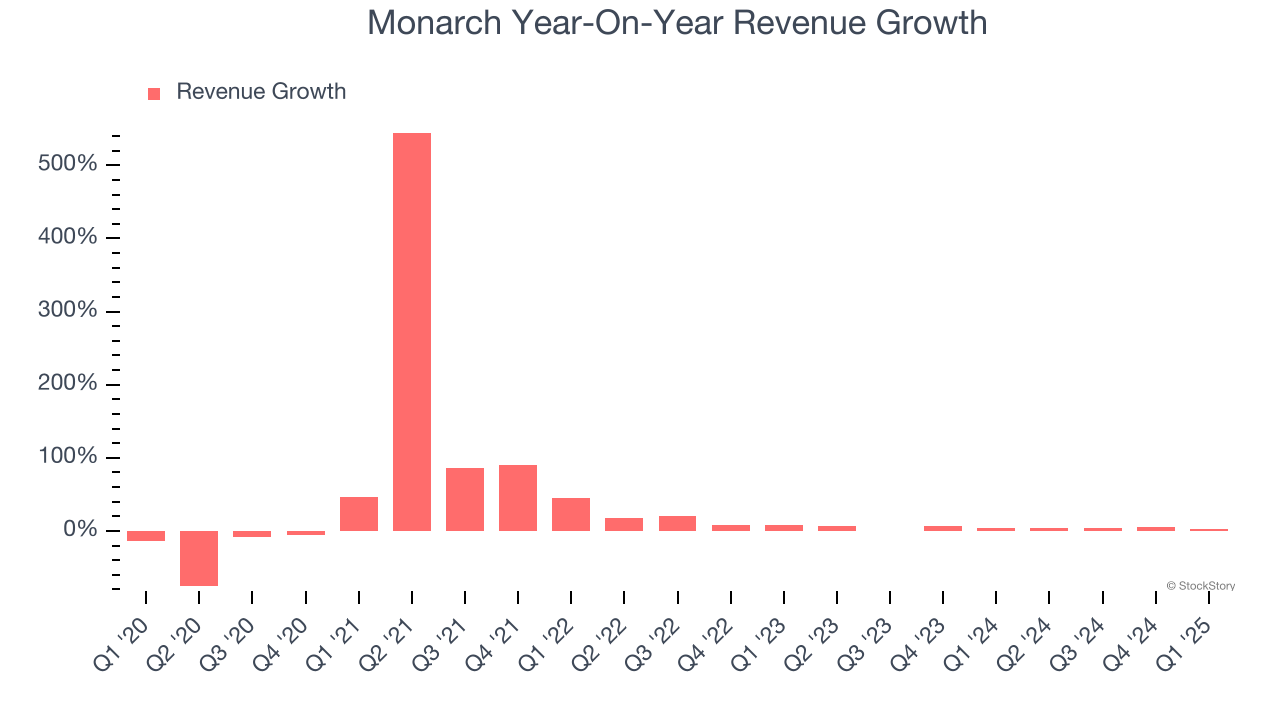
Luxury casino and resort operator Monarch (NASDAQ: MCRI) reported revenue ahead of Wall Street’s expectations in Q1 CY2025, with sales up 3.1% year on year to $125.4 million. Its GAAP profit of $1.05 per share was 6.1% above analysts’ consensus estimates.
Is now the time to buy Monarch? Find out by accessing our full research report, it’s free.
Monarch (MCRI) Q1 CY2025 Highlights:
- Revenue: $125.4 million vs analyst estimates of $122.8 million (3.1% year-on-year growth, 2.1% beat)
- EPS (GAAP): $1.05 vs analyst estimates of $0.99 (6.1% beat)
- Adjusted EBITDA: $41.13 million vs analyst estimates of $39.48 million (32.8% margin, 4.2% beat)
- Operating Margin: 20.2%, in line with the same quarter last year
- Market Capitalization: $1.36 billion
Company Overview
Established in 1993, Monarch (NASDAQ: MCRI) operates luxury casinos and resorts, offering high-end gaming, dining, and hospitality experiences.
Casino Operator
Casino operators enjoy limited competition because gambling is a highly regulated industry. These companies can also enjoy healthy margins and profits. Have you ever heard the phrase ‘the house always wins’? Regulation cuts both ways, however, and casinos may face stroke-of-the-pen risk that suddenly limits what they can or can't do and where they can do it. Furthermore, digitization is changing the game, pun intended. Whether it’s online poker or sports betting on your smartphone, innovation is forcing these players to adapt to changing consumer preferences, such as being able to wager anywhere on demand.
Sales Growth
A company’s long-term sales performance can indicate its overall quality. Even a bad business can shine for one or two quarters, but a top-tier one grows for years. Luckily, Monarch’s sales grew at a decent 16.8% compounded annual growth rate over the last five years. Its growth was slightly above the average consumer discretionary company and shows its offerings resonate with customers.

Long-term growth is the most important, but within consumer discretionary, product cycles are short and revenue can be hit-driven due to rapidly changing trends and consumer preferences. Monarch’s recent performance shows its demand has slowed as its annualized revenue growth of 4% over the last two years was below its five-year trend. Note that COVID hurt Monarch’s business in 2020 and part of 2021, and it bounced back in a big way thereafter. 
Monarch also breaks out the revenue for its three most important segments: Casino, Dining, and Hotel, which are 58.1%, 23.9%, and 13.3% of revenue. Over the last two years, Monarch’s revenues in all three segments increased. Its Casino revenue (Poker, Blackjack) averaged year-on-year growth of 4.2% while its Dining (food and beverage) and Hotel (overnight stays) revenues averaged 2.9% and 3.5%.
This quarter, Monarch reported modest year-on-year revenue growth of 3.1% but beat Wall Street’s estimates by 2.1%.
Looking ahead, sell-side analysts expect revenue to grow 1.9% over the next 12 months, a slight deceleration versus the last two years. This projection doesn't excite us and suggests its products and services will see some demand headwinds.
Here at StockStory, we certainly understand the potential of thematic investing. Diverse winners from Microsoft (MSFT) to Alphabet (GOOG), Coca-Cola (KO) to Monster Beverage (MNST) could all have been identified as promising growth stories with a megatrend driving the growth. So, in that spirit, we’ve identified a relatively under-the-radar profitable growth stock benefiting from the rise of AI, available to you FREE via this link.
Operating Margin
Monarch’s operating margin has risen over the last 12 months and averaged 22.5% over the last two years. On top of that, its profitability was elite for a consumer discretionary business thanks to its efficient cost structure and economies of scale.

In Q1, Monarch generated an operating profit margin of 20.2%, in line with the same quarter last year. This indicates the company’s overall cost structure has been relatively stable.
Earnings Per Share
Revenue trends explain a company’s historical growth, but the long-term change in earnings per share (EPS) points to the profitability of that growth – for example, a company could inflate its sales through excessive spending on advertising and promotions.
Monarch’s EPS grew at an astounding 28.6% compounded annual growth rate over the last five years, higher than its 16.8% annualized revenue growth. This tells us the company became more profitable on a per-share basis as it expanded.

In Q1, Monarch reported EPS at $1.05, up from $0.93 in the same quarter last year. This print beat analysts’ estimates by 6.1%. Over the next 12 months, Wall Street expects Monarch’s full-year EPS of $5.07 to shrink by 1.4%.
Key Takeaways from Monarch’s Q1 Results
It was encouraging to see Monarch beat analysts’ revenue expectations this quarter, even though its Casino segment fell short. We were also happy its EPS and EBITDA outperformed Wall Street’s estimates. Overall, this quarter had some key positives. The stock remained flat at $76.03 immediately after reporting.
Sure, Monarch had a solid quarter, but if we look at the bigger picture, is this stock a buy? The latest quarter does matter, but not nearly as much as longer-term fundamentals and valuation, when deciding if the stock is a buy. We cover that in our actionable full research report which you can read here, it’s free.






